Lessico
Gallitrico
Gallitricum - Gallitrichum - Centrum galli
Sclarea - Salvia sclarea - Sclaraggine
Nella
terminologia botanica è stato messo un po' d'ordine da Linneo![]() (1707-1778). Ma già due secoli prima vi si era cimentato Pierandrea Mattioli
(1707-1778). Ma già due secoli prima vi si era cimentato Pierandrea Mattioli![]() (1500-1577) disquisendo sui qui pro quo relativi a salvia e gallitrico nei
suoi commenti a Dioscoride
(1500-1577) disquisendo sui qui pro quo relativi a salvia e gallitrico nei
suoi commenti a Dioscoride![]() .
.
Lo
stesso Gessner riferisce alcuni qui pro quo a pagina 403![]() di Historia animalium III (1555) di cui citiamo un frammento:
di Historia animalium III (1555) di cui citiamo un frammento:
L'alectorolophos,
che presso di noi è detta cresta - Rhinanthus
crista-galli/cresta di gallo![]() ,
ha le foglie simili alle cresta di un gallo, Plinio
,
ha le foglie simili alle cresta di un gallo, Plinio![]() .
Matteo Silvatico
.
Matteo Silvatico![]() lo traduce con gallitrico -
o Salvia sclarea, o sclaraggine -
altrimenti detto volgarmente sperone di gallo, etc.
lo traduce con gallitrico -
o Salvia sclarea, o sclaraggine -
altrimenti detto volgarmente sperone di gallo, etc.
Vediamo cose scrisse Mattioli.
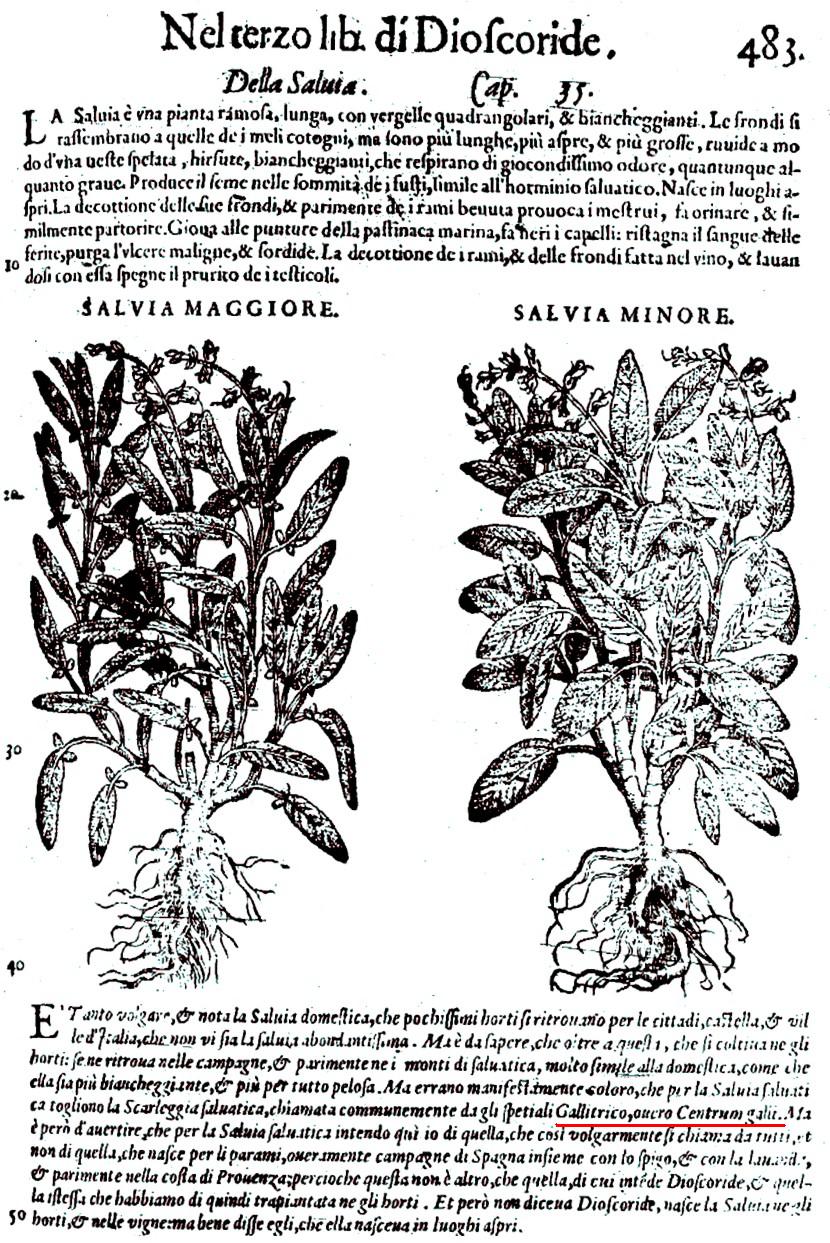
La salvia si chiama così in quanto rende salvus, per le proprietà terapeutiche. Il genere Salvia appartiene alla famiglia delle Labiate con circa 500 specie proprie delle regioni temperate e subtropicali dell'emisfero settentrionale.
Sono suffrutici con forte odore aromatico e foglie ovate, oblunghe o cuoriformi, di colore verde-grigiastro, pelose e rugose, con apice più o meno arrotondato. I fiori sono gamopetali, labiati, di color viola, azzurrino o giallo secondo le specie, riuniti in spicastri terminali; i frutti sono acheni.
Salvia
officinalis
Salvia domestica
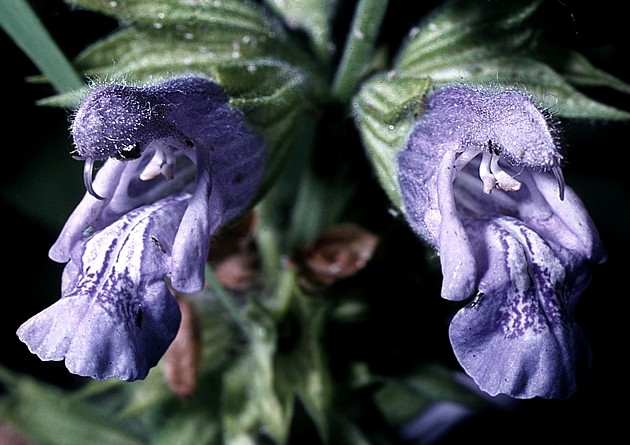
Salvia
officinalis
Elio Corti - 1972
La specie più nota è la Salvia officinalis (salvia domestica, erba sacra, erba santa), che cresce spontanea in varie regioni del Mediterraneo, dove è anche oggetto di coltivazione. Molto apprezzata nei tempi passati come rimedio per varie malattie, la salvia comune gode tuttora di buona fama nella medicina popolare, soprattutto come stimolante della funzione digestiva e per combattere l'eccessiva sudorazione negli stati reumatici. Dalle foglie - di cui è ben noto l'impiego in cucina come aromatizzante - e dalle sommità fiorite si estrae un'essenza usata in profumeria. Strofinarsi le gengive con foglie di salvia pare sia un metodo efficace per attenuare le infiammazioni della mucosa.
Salvia
sclarea
Salvia moscatella
Specie congenere è la Salvia sclarea, detta sclarea o sclaraggine,
oppure gallitrico, oppure salvia moscatella, spontanea nell'Europa meridionale, coltivata per le sommità
fiorite che hanno profumo moscato, usate per aromatizzare i vini, in
particolare il vermouth. In
passato veniva detta horminum, dal greco hórminon, di cui
parlarono sia Teofrasto![]() che Dioscoride. Hórminon
deriva dal verbo hormáø che significa io eccito, in quanto, come
specifica Alexandre Théis (Glossaire de botanique, 1810), Dioscoride (III,78)
afferma che l'hórminon è afrodisiaco.
che Dioscoride. Hórminon
deriva dal verbo hormáø che significa io eccito, in quanto, come
specifica Alexandre Théis (Glossaire de botanique, 1810), Dioscoride (III,78)
afferma che l'hórminon è afrodisiaco.
Non chiedetemi perché la moscatella fu battezzata gallitricum,
oppure gallitrichum (capello, criniera, ciuffo, barba del gallo) oppure centrum
galli (sperone del gallo). Non so assolutamente rispondervi, nonostante le ricerche
affannosamente effettuate dal momento che è implicato il gallo, salvo si tratti di un
Gallo![]() ,
ovviamente di stirpe celtica
,
ovviamente di stirpe celtica![]() .
.
Ma il gallo, quello che fa chicchirichì, chiedeva giustizia, e allora mi sono rivolto alla Dottoressa Gloria Sirianni, Docente di Dialettologia presso il Dipartimento di Linguistica dell'Università di Firenze, che non poteva non sciogliere il busillis. Infatti ecco la sua risposta, che in sintesi afferma trattarsi di una pianta dalla bella chioma e che quindi andrebbe scritta con ch: gallitrichum. Ne viene così escluso il gallo, anche se un problema rimane ancora insoluto: centrum galli significa senz'altro sperone di gallo.
Per quel pochissimo che so a proposito delle denominazioni di piante, le ragioni potrebbero essere:
- usuale
riferimento all'aspetto esteriore
- fiori o foglie
- colore o portamento o uso
ma in questo caso del gallitricum non credo che se ne nutrano i galli (anche se potrebbe esserci qualche gallo amante del vermouth!).
Vi è poi il vastissimo problema delle etimologie popolari o paretimologie: un termine dotto ormai diventato 'opaco' non comprensibile, si riporta a una base nota 'trasparente' quindi il riferimento al gallo (non ai capelli, perché rimane il termine greco) potrebbe essere paretimologico, e bisogna cercare una base diversa per la prima parte del termine.
La cosa mi intriga e quindi interrompo e mi guardo il Dizionario Etimologico Italiano di Battisti e Alessio (che per fortuna posseggo), che rimanda infatti a un dotto callìtrice (callìtrica, callìtriche) lat. callitrichos (Marcello Empirico, Dioscoride), dal greco kallitrichon (Dioscoride), dall'aggettivo kallithrix e kallitrichos che ha una bella chioma 'calli-' e 'thrix –trichòs' capello.
Come vede a volte la soluzione è molto semplice! Io sapevo che nel vermouth si metteva l'artemisia assenzio (pianta i cui nomi ho studiato alcuni anni fa), ma non anche la salvia. (e-mail di mercoledì 23 gennaio 2008)
Quindi per gallitrichum si è verificato ciò che è accaduto al toponimo Gallipoli. Dal punto di vista toponomastico non si tratta di una città in cui vengono allevati galli né di un centro fondato dai Galli. Si tratta semplicemente di una bella città, Kallípolis, termine generato dal greco kalë = bella e pólis = città. La nostra Gallipoli in provincia di Lecce prima si chiamava Anxa grazie ai Messapi che abitavano la penisola Salentina, per diventare Kallípolis quando a partire dall'VIII secolo aC fece parte della Magna Grecia. Anche Gallipoli della Turchia europea (oggi Gelibolu, penisola del Chersoneso, sponda settentrionale dello stretto dei Dardanelli) un tempo si chiamava Kallípolis, nome attribuitole dagli Ateniesi che ne erano stati i fondatori.
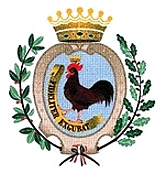


A
Gallipoli il gallo la fa ancora da padrone
Fideliter excubat
Vigila scrupolosamente
Contrariamente a quanto suggerito dal gonfalone cittadino, su cui campeggia un gallo, la radice del nome Gallipoli non pare avere nulla a che vedere con l'animale. Secondo un'opinione diffusa la parola Gallipoli deriverebbe dal greco kalé pólis, che significa "città bella". Alcuni studi, invece, riconducono l'origine del nome al toponimo kal, in questo caso nella sua variante gal, presente anche nei toponimi salentini Calimera, Galugnano, Alliste (originariamente Calliste). Stando a quest'ultima ipotesi, Gallipoli significherebbe "città dello scalo" oppure "dell'emporio/fondaco". - web
Per centrum galli abbozzo un'ipotesi etimologica da cerebroleso: magari il tricum di gallitricum è stato posto davanti a galli e poi, da qualcuno appassionato di speroni e di gallomachie, è stato semianagrammato in centrum. Lo so, è una soluzione da cerebroleso. Fatto sta che la sommità fiorita della Salvia sclarea è sì slanciata, ma a me non ricorda assolutamente lo sperone del gallo. Però, se osserviamo il petalo superiore di un fiore di Salvia sclarea, esso si presenta arcuato e ricorda benissimo lo sperone di un gallo, molto più di quanto accada per lo stesso petalo della Salvia officinalis. Forse è proprio questa la soluzione etimologica per centrum galli.


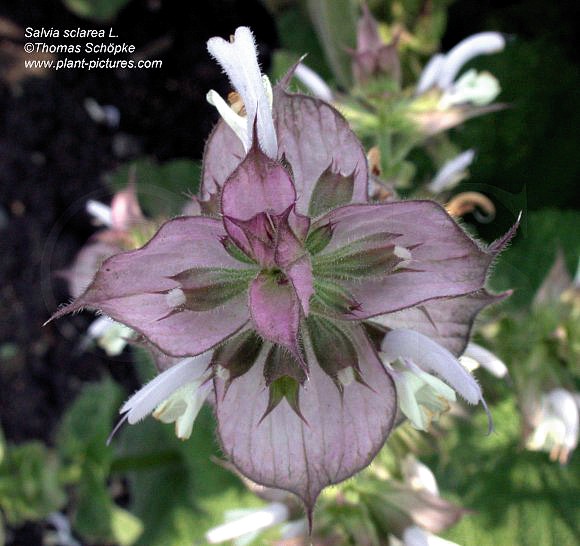
Salvia
sclarea
Clary
Synonyms -
Clarry. Orvale. Toute-bonne. Clear Eye. See Bright. Eyebright.
Parts
Used -The herb and leaves, both fresh and dry.
Habitat - Middle Europe.
Common Clary, like the Garden Sage, is not a native of Great Britain, having first been introduced into English cultivation in the year 1562. It is a native of Syria, Italy, southern France and Switzerland, but will thrive here upon almost any soil that is not too wet, though it will rot frequently upon moist ground in the winter.
Gerard, in 1597, describes and figures several varieties of Clary, under the names of Horminum and Gallitricum. He describes it as growing 'in divers barren places almost in every country, especially in the fields of Holborne neare unto Grayes Inne . . . and at the end of Chelsea.' It must have become acclimatized very quickly if it was found 'in divers barren places' before the close of the sixteenth century, less than forty years after its introduction into the country.
Salmon, in 1710, in The English Herbal, gives a number of varieties of the Garden Clary, which he calls Horminum Hortense, in distinction to Horminum Sylvestre, the Wild Clary, subdividing it into the Common Clary (H. commune), the True Garden Clary of Dioscorides (H. sativum verum Dioscorides), the Yellow Clary (Calus Jovis), and the Small or German Clary (H. humile Germanicum or Gallitricum alterum Gerardi). It is interesting to note that this last variety, being termed Gerardi, indicates that Gerard classified this species when it was first brought over from the Continent, evidently taking great pains to trace its history, giving in his Herball its Greek name and its various Latin ones. That Clary was known in ancient times is shown by the second variety, the True Garden Clarv being termed Dioscoridis.
Description
The Common Garden Clary is a biennial plant, its square, brownish stems growing 2 to 3 feet high, hairy and with few branches. The leaves are arranged in pairs, almost stalkless, and are almost as large as the hand, oblong and heart-shaped, wrinkled, irregularly toothed at the margins and covered with velvety hairs. The flowers are in a long, loose, terminal spike, on which they are set in whorls. The lipped corollas, similar to the Garden Sage, but smaller, are of a pale blue or white. The flowers are interspersed with large coloured, membraneous bracts, longer than the spiny calyx. Both corollas and bracts are generally variegated with pale purple and yellowish-white. The seeds are blackish brown, 'contained in long toothed husks,' as an old writer describes the calyx. The whole plant possesses a very strong, aromatic scent, somewhat resembling that of Tolu, while the taste is also aromatic, warm and slightly bitter.
History
According to Ettmueller, this herb was first brought into use by the wine merchants of Germany, who employed it as an adulterant, infusing it with Elder flowers, and then adding the liquid to the Rhenish wine, which converted it into a Muscatel. It is still called in Germany Muskateller Salbei (Muscatel Sage).
Waller (1822) states it was also employed in this country as a substitute for Hops, for sophisticating beer, communicating considerable bitterness and intoxicating property, which produced an effect of insane exhilaration of spirits, succeeded by severe headache. Lobel says: 'Some brewers of Ale and Beere doe put it into their drinke to make it more heady, fit to please drunkards, who thereby, according to their several dispositions, become either dead drunke, or foolish drunke, or madde drunke.'
In some parts of the country, a wine has been made from the herb in flower, boiled with sugar, which has a flavour not unlike Frontiniac.
Though employed in ancient times and in the Middle Ages for its curative properties, it seems to have fallen into disuse as a medicinal plant, though revived to a certain extent towards the end of the nineteenth century.
The English name Clary originates in the Latin specific name sclarea, a word derived from clarus (clear). This name Clary was gradually modified into 'Clear Eye,' one of the popular names and generally explained from the fact that the seeds have been employed for clearing the sight, being so mucilaginous that a decoction from them placed in the eye would 'clear' it from any small foreign body, the presence of which might have caused irritation.
Although the Garden Clary has much fallen into disuse as a medicine, there is a big trade done in it now, mainly in France, for the extraction of its oil as a perfume fixer, and there is undoubtedly a big future ahead for it for this purpose, not only on the Continent, but also in this country.
Uses
The leaves are used to adulterate digitalis. The dried root and the seeds were formerly used in domestic medicine.
Cultivation
Clary is propagated by seed, which should be sown in the spring. When fit to move, the seedlings should be transplanted to an open piece of ground, a foot apart each way, if required in large quantities. After the plants have taken root, they will require no further care but to be kept free of weeds. The winter and spring following, the leaves will be in perfection. As the plant is a biennial only, dying off the second summer, after it has ripened its seeds, there should be young plants annually raised for use.
Constituents
Salvia sclarea yields an oil with a highly aromatic odour, resembling that of ambergris. It is known commercially as Clary Oil, or Muscatel Sage, and is largely used as a fixer of perfumes. Pinene, cineol, and linalol have been isolated from this oil.
French Oil of Clary has a specific gravity of 0.895 to 0.930, and is soluble in two volumes of 80 per cent. alcohol. German oil of Clary has a specific gravity of 0.910 to 0.960, and is soluble in two volumes of 90 per cent alcohol.
Medicinal Action and Uses
Antispasmodic, balsamic, carminative, tonic, aromatic, aperitive, astringent and pectoral. It has mostly been employed in disordered states of the digestion, as a stomachic, and has also proved useful in kidney diseases.
The seeds when soaked in water for a few minutes form a thick mucilage, which is efficacious in removing particles of dust from the eye. Gerard says: 'It purgeth them exceedingly from the waterish humerous rednesse, inflammation, and drives other maladies or all that happens unto the eies and takes away the paine and smarting thereof, especially being put into the eies one seed at a time and no more.'
Culpepper tells us: 'For tumours, swellings, &c., make a mucilage of the seeds and apply to the spot. This will also draw splinters and thorns out of the flesh.... For hot inflammation and boils before they rupture, use a salve made of the leaves boiled with hot vinegar, honey being added later till the required consistency is obtained.'
He recommends a powder of the dry roots taken as snuff to relieve headache, and 'the fresh leaves, fried in butter, first dipped in a batter of flour, egges, and a little milke, serve as a dish to the table that is not unpleasant to any and exceedingly profitable.'
The juice of the herb drunk in ale and beer, as well as the ordinary infusion, has been recommended as very helpful in all women's diseases and ailments.
In Jamaica, where the plant is found, it was much in use among the negroes, who considered it cooling and cleansing for ulcers, and also used it for inflammations of the eyes. A decoction of the leaves boiled in coco-nut oil was used by them to cure the stings of scorpions. Clary and a Jamaican species of Vervain form two of the ingredients of an aromatic warm bath sometimes prescribed there with benefit.
For violent cases of hysteria or wind colic, a spirituous tincture has been found of use, made by macerating in warm water for fourteen days, 2 OZ. of dried Clary leaves and flowers, 1 OZ. of Chamomile flowers, 1/2 oz. bruised Avens root, 2 drachms of bruised Caraway and Coriander seeds, and 3 drachms of bruised Burdock seeds, adding 2 pints of proof spirit, then filtering and diluting with double quantity of water - a wineglassful being the dose.
http://botanical.com
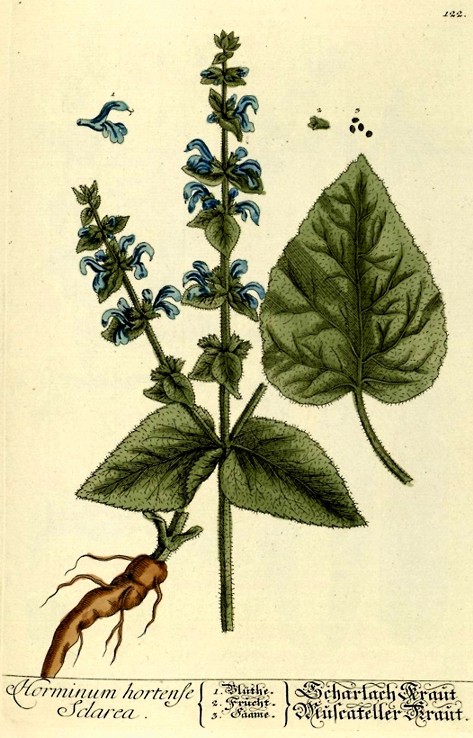
Herbarium
Blackwellianum emendatum et auctum, idest,
Collectio stirpium: Quae in pharmacopoliis ad medicum asservantur, quarum
descriptio et vires...
Elisabethae Blackwell; cum praefatione Christoph. Iacobi Trew;
excudit figuras pinxit atque in aes incidit Nicolaus Fridericus
Eisenbergerus / Vol. I
Nuremberg: Christian de Launoy, 1757
Salvia
sclarea
Clary Sage
This is the quintessential European dream herb and is much easier to grow and acquire than exotic New World herbs used for that purpose. Because of its association with dreamwork, this magick herb is usually thought to be ruled by Moon, but its effect on the mind makes some consider it a Mercury herb. Whichever the correspondence, clary sage finds great use in creating very vivid dreams and aiding in dream recall, especially in terms of divinatory dreams. It is generally helpful in building skills of clairvoyance. Although historians say that this magick herb was introduced to Great Britain during the Renaissance, some believe that the invading Romans brought it with them, so it's useful for rites honoring deities like Luna, Diana, or Juno or consecrating tools to be used in works dedicated to them.Some write wishes on the leaves, which can be up to a foot long, and then put them under their pillow before going to bed. Subsequent dreams reveal whether the wish will come true or not. If not, the leaf should be buried. This magick herb is also a candidate for incense, since it is one of the few dried mints that does not smell disgusting when burned. Many perceive muskiness in the scent of clary sage and it is also a fixative of scent, so it is associated with Elemental Earth. For that reason, it can be incorporated into love/sex magick - steep a muslin bag of leaves in bath water before a romantic evening, for instance. According to Culpeper, this herb "provoketh to venery."
Mundane uses
Clary sage is a euphoric herb but can be sedating, so don't use it when you have to drive. Together with elder flowers, it was a flavoring of Rhine wine and so gave its name to muscatel (because some believe it smells musky). It was also added to beer to increase its intoxicating qualities. Unlike hops, it tended to provoke an active rather than a stupefying drunkenness, but it is best not to combine it with alcohol, as it can cause extreme drunkenness and a very bad headache later. By itself, it helps elevate mood and restore confidence, aids in releasing emotions, and encourages us to focus on the moment. Although it is no longer used medicinally, in Culpeper's day, the leaves were battered and fried in butter as a medicinal food for a weak back. It was once added to smoking tobacco for flavoring. Some consider the scent of clary sage to be similar to that of ambergris, and it is indeed an ingredient in many recipes for vegetable ambergris. More practically, this plant also concentrates heavy metals from the soil and can be planted to clear contaminated areas. It should then be disposed of rather than composted. Clary sage is also known as muscatel sage, clear eye, see bright, horminum, and gallitricum.
How to grow Clary Sage
Barely cover seeds to germinate in two weeks in room temperature. Plant out in full sun after all danger of frost is over. It forms a rosette the first year and the second shoots up stalks of mint-like flowers that can be pink, lavender, or blue and that are 24-36"/ 61-91cm tall. This plant is biennial but usually lives longer than two years. It's hardy down to -20F/-28C (zones 5-9). Harvest the flowering tops in the early morning for highest essential oil content. Some believe it is best to harvest clary sage during the Balsamic phase of the Moon. Like all mints, it can be aggressive. It is a good idea to plant members of the mint family in areas where their lively reproductive capabilities will not be a problem, such as areas bordered by pavement or grass, where unwanted plants can just be mowed down.
www.alchemy-works.com
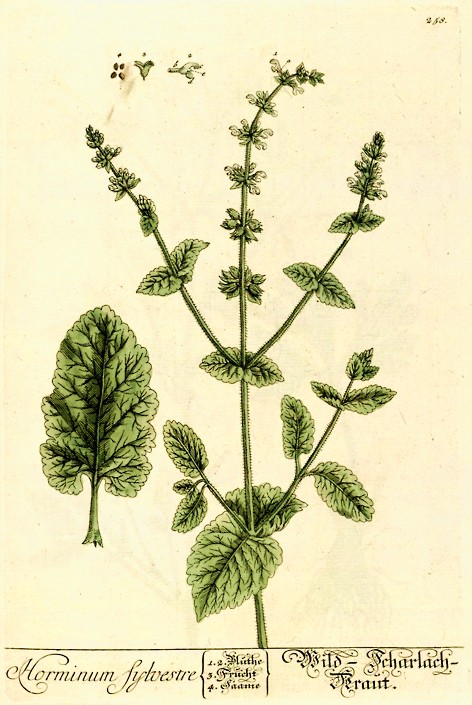
Herbarium
Blackwellianum emendatum et auctum, idest,
Collectio stirpium: Quae in pharmacopoliis ad medicum asservantur, quarum
descriptio et vires...
Elisabethae Blackwell; cum praefatione Christoph. Iacobi Trew;
excudit figuras pinxit atque in aes incidit Nicolaus Fridericus
Eisenbergerus / Vol. I
Nuremberg: Christian de Launoy, 1757